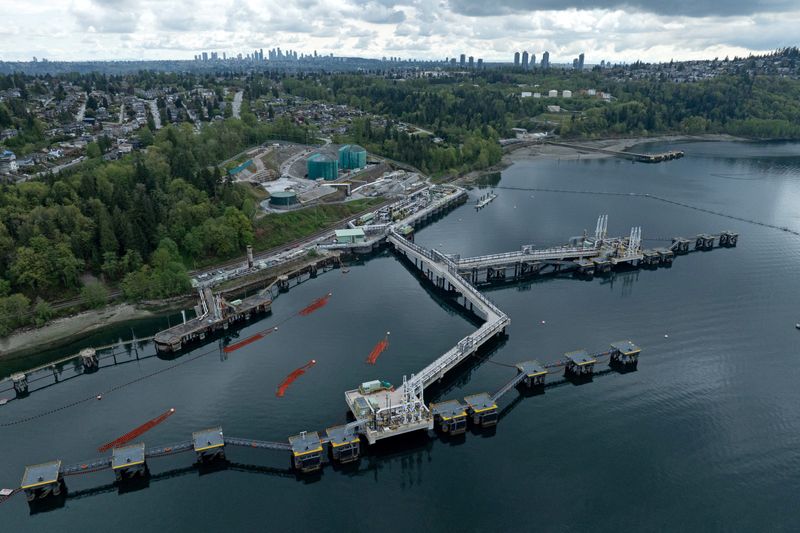Commodities
Trans Mountain oil pipeline just shy of target for first-month loadings

By Arathy Somasekhar
HOUSTON (Reuters) – About 20 ships loaded on Canada’s West Coast in the first full month of operation on the newly expanded Trans Mountain pipeline, according to vessel-tracking data on Sunday, slightly below the operator’s forecast.
Loadings from the pipeline expansion are closely watched because the Canadian government wants to sell the $24.84 billion (C$34 billion) line. Questions about oil quality, pipeline economics and loading challenges have swirled since its startup, spurring concerns over demand and exports of the crude.
The 20 vessels loaded were less than the 22 ships that Trans Mountain had initially expected to load for the month.
Total crude exports from Vancouver were around 350,000 barrels per day with the last two vessels for June-loading at the Westridge Marine terminal, as of Sunday.
“This first month is just shy of the 350,000-400,000 bpd we expected ahead of the startup. We are still in the discovery phase, with kinks being ironed out … but in the grand scheme of things, this has been a solid start,” said Matt Smith, lead analyst at Kpler.
The vessels, partially loaded Aframaxes able to carry about 550,000 barrels each, mostly sailed to the U.S. West Coast and Asia. Some cargoes were loaded onto larger ships for delivery to India and China, according to data providers LSEG, Kpler and Vortexa.
Reliance Industries bought 2 million barrels of Canadian crude for July delivery, a deal that involved four ship-to-ship transfers to load the oil onto a very large crude carrier offshore California. The oil is destined for Sikka, India, where the company operates the world’s biggest refining complex.
Phillips 66 (NYSE:) acquired a cargo for its Ferndale, Washington, refinery, Marathon Petroleum Corp (NYSE:) for its Los Angeles refinery, and Valero Energy Corp (NYSE:) for its Benicia, California, refinery.
TMX did not immediately respond ahead of a long weekend in Canada. Phillips 66 and Marathon Petroleum declined to comment, while Valero did not reply to a request for comments.
The market was expecting about 17 to 18 loadings, said Rohit Rathod, market analyst at energy researcher Vortexa.
“Chinese demand has been below expectations, and if not for Reliance most of the barrels in June would have remained within the (West Coast) region,” Rathod added.
Trans Mountain this month revised standards for accepting crude oil on its recently expanded system, alleviating worries about the acidity and vapor pressure of the line’s crude oil.

Logistical constraints in a busy, narrow shipping channel after leaving the Westridge dock in Vancouver were also expected to impact loadings. To manage high traffic in the channel, the Port of Vancouver has restrictions on transit times.
The expanded Trans Mountain pipeline is running around 80% full with some spot capacity used. Trans Mountain forecasts 96% utilization from next year. It has capacity to load 34 Aframax ships a month.
(By Arathy Somasekhar in Houston; additional reporting by Nia Williams in British Columbia; Editing by Sherry Jacob-Phillips)
Commodities
Oil prices rise; U.S. crude inventories plunge, Russia-Ukraine truce eyed
Commodities
India’s Reliance to stop buying Venezuelan oil over US tariffs, sources say
Commodities
Oil prices climb on Venezuela supply worries

 Forex3 years ago
Forex3 years agoForex Today: the dollar is gaining strength amid gloomy sentiment at the start of the Fed’s week

 Forex3 years ago
Forex3 years agoUnbiased review of Pocket Option broker

 Forex3 years ago
Forex3 years agoDollar to pound sterling exchange rate today: Pound plummeted to its lowest since 1985

 Forex3 years ago
Forex3 years agoHow is the Australian dollar doing today?

 Cryptocurrency3 years ago
Cryptocurrency3 years agoWhat happened in the crypto market – current events today

 World3 years ago
World3 years agoWhy are modern video games an art form?

 Commodities3 years ago
Commodities3 years agoCopper continues to fall in price on expectations of lower demand in China

 Economy3 years ago
Economy3 years agoCrude oil tankers double in price due to EU anti-Russian sanctions























